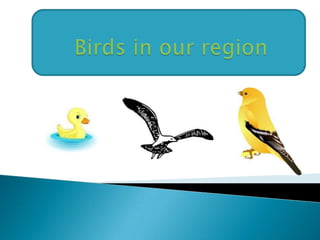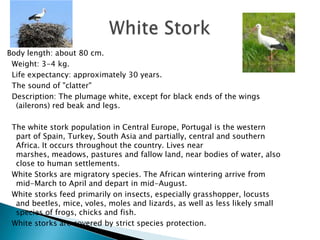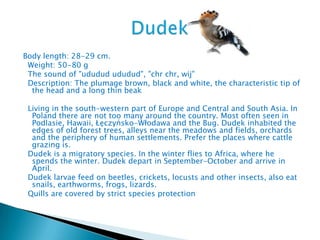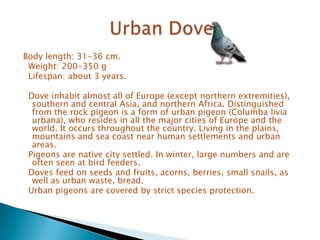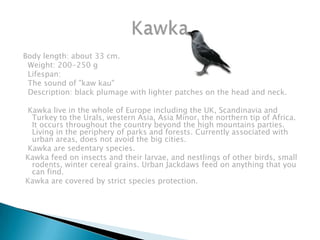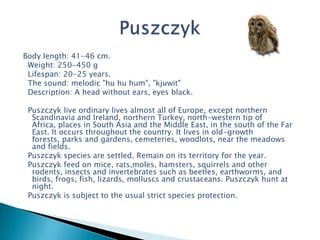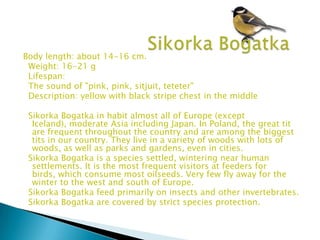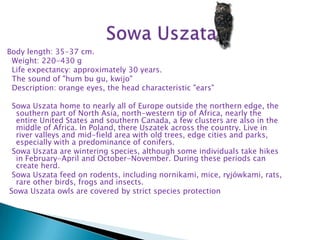Birds in our region
- 2. Body length: about 80 cm. Weight: 3-4 kg. Life expectancy: approximately 30 years. The sound of "clatter" Description: The plumage white, except for black ends of the wings (ailerons) red beak and legs. The white stork population in Central Europe, Portugal is the western part of Spain, Turkey, South Asia and partially, central and southern Africa. It occurs throughout the country. Lives near marshes, meadows, pastures and fallow land, near bodies of water, also close to human settlements. White Storks are migratory species. The African wintering arrive from mid-March to April and depart in mid-August. White storks feed primarily on insects, especially grasshopper, locusts and beetles, mice, voles, moles and lizards, as well as less likely small species of frogs, chicks and fish. White storks are covered by strict species protection.
- 3. Body length: 28-29 cm. Weight: 50-80 g The sound of "ududud ududud", "chr chr, wij" Description: The plumage brown, black and white, the characteristic tip of the head and a long thin beak Living in the south-western part of Europe and Central and South Asia. In Poland there are not too many around the country. Most often seen in Podlasie, Hawaii, Łęczyńsko-Włodawa and the Bug. Dudek inhabited the edges of old forest trees, alleys near the meadows and fields, orchards and the periphery of human settlements. Prefer the places where cattle grazing is. Dudek is a migratory species. In the winter flies to Africa, where he spends the winter. Dudek depart in September-October and arrive in April. Dudek larvae feed on beetles, crickets, locusts and other insects, also eat snails, earthworms, frogs, lizards. Quills are covered by strict species protection
- 4. Body length: about 23 cm. Weight: 75-95 g Life expectancy: approximately 10 years. The sound of "kiks, kikiki", "Cili cjur cyli cjur" Description: in the lower abdomen red spot, abdomen clear, back black with white stripes. Woodpecker inhabit almost all of Europe (except for its northern extremes, the United Kingdom, Italy and Greece) and the central part of Asia to Japan. It occurs throughout the country. Living in the old deciduous forests, coniferous (pine) or mixed with a touch of aspen, old cemeteries, parks and avenues near human settlements. Woodpecker is a species settled. In winter you can meet feeders are for the birds. Juveniles can take hiking to find new nesting sites. Woodpecker feeds on insect larvae living in the tree, ants and their larvae, caterpillars, nuts, seeds beech, pine and spruce. Very rarely eats small birds, chicks and fruit. Woodpecker is covered by strict species protection.
- 5. Body length: 31-36 cm. Weight: 200-350 g Lifespan: about 3 years. Dove inhabit almost all of Europe (except northern extremities), southern and central Asia, and northern Africa. Distinguished from the rock pigeon is a form of urban pigeon (Columba livia urbana), who resides in all the major cities of Europe and the world. It occurs throughout the country. Living in the plains, mountains and sea coast near human settlements and urban areas. Pigeons are native city settled. In winter, large numbers and are often seen at bird feeders. Doves feed on seeds and fruits, acorns, berries, small snails, as well as urban waste, bread. Urban pigeons are covered by strict species protection.
- 6. Body length 17-23 cm. Weight: 16-24 g Lifespan: 10-16 years. The sound of "wit wit, ciwit ciwit, widewidit" Description: back with a blue tail, glossy, brown spot on her neck. Jaskółka Dymówka home to nearly all of Europe (except the north), the northern part of Africa, south-eastern part of Asia, and almost all of the Americas. In Poland, there are very large numbers throughout the country. Swallow live near human settlements, mainly related to rural areas. Jaskółka are migratory species. In winter, fly to Africa (from September to mid-October) and come back at the end of March or early April. Dymówka feed on small insects captured on the fly, which mainly include wasps, beetles and flies (including mosquitoes, gadflies and flies). Jaskółka Dymówka under strict species protection.
- 7. Body length: 50-65 cm. Weight: 750-1570 g Body length: up to about 30 years. Mallard duck population across Europe, North Africa ends almost all of Asia, Asia Minor and North America. It occurs throughout the country. Living in almost all bodies of water, especially with the lush vegetation offshore, also in the cities. Ducks are native to partially settled. Some overwinter, especially in the cities, others depart between August and December in warmer regions and return between February and April. Mallard ducks mainly feed on aquatic plants, bukwią, and the larvae of mosquitoes, chrząszczów, shellfish and other aquatic animals. Mallard ducks are a species hunted in the period from 15 August to 21 December.
- 8. Body length: about 33 cm. Weight: 200-250 g Lifespan: The sound of "kaw kau" Description: black plumage with lighter patches on the head and neck. Kawka live in the whole of Europe including the UK, Scandinavia and Turkey to the Urals, western Asia, Asia Minor, the northern tip of Africa. It occurs throughout the country beyond the high mountains parties. Living in the periphery of parks and forests. Currently associated with urban areas, does not avoid the big cities. Kawka are sedentary species. Kawka feed on insects and their larvae, and nestlings of other birds, small rodents, winter cereal grains. Urban Jackdaws feed on anything that you can find. Kawka are covered by strict species protection.
- 9. Body length: 41-46 cm. Weight: 250-450 g Lifespan: 20-25 years. The sound: melodic "hu hu hum", "kjuwit" Description: A head without ears, eyes black. Puszczyk live ordinary lives almost all of Europe, except northern Scandinavia and Ireland, northern Turkey, north-western tip of Africa, places in South Asia and the Middle East, in the south of the Far East. It occurs throughout the country. It lives in old-growth forests, parks and gardens, cemeteries, woodlots, near the meadows and fields. Puszczyk species are settled. Remain on its territory for the year. Puszczyk feed on mice, rats,moles, hamsters, squirrels and other rodents, insects and invertebrates such as beetles, earthworms, and birds, frogs, fish, lizards, molluscs and crustaceans. Puszczyk hunt at night. Puszczyk is subject to the usual strict species protection.
- 10. Body length: about 14-16 cm. Weight: 16-21 g Lifespan: The sound of "pink, pink, sitjuit, teteter" Description: yellow with black stripe chest in the middle Sikorka Bogatka in habit almost all of Europe (except Iceland), moderate Asia including Japan. In Poland, the great tit are frequent throughout the country and are among the biggest tits in our country. They live in a variety of woods with lots of woods, as well as parks and gardens, even in cities. Sikorka Bogatka is a species settled, wintering near human settlements. It is the most frequent visitors at feeders for birds, which consume most oilseeds. Very few fly away for the winter to the west and south of Europe. Sikorka Bogatka feed primarily on insects and other invertebrates. Sikorka Bogatka are covered by strict species protection.
- 11. Body length: 35-37 cm. Weight: 220-430 g Life expectancy: approximately 30 years. The sound of "hum bu gu, kwijo" Description: orange eyes, the head characteristic "ears" Sowa Uszata home to nearly all of Europe outside the northern edge, the southern part of North Asia, north-western tip of Africa, nearly the entire United States and southern Canada, a few clusters are also in the middle of Africa. In Poland, there Uszatek across the country. Live in river valleys and mid-field area with old trees, edge cities and parks, especially with a predominance of conifers. Sowa Uszata are wintering species, although some individuals take hikes in February-April and October-November. During these periods can create herd. Sowa Uszata feed on rodents, including nornikami, mice, ryjówkami, rats, rare other birds, frogs and insects. Sowa Uszata owls are covered by strict species protection
- 12. Body length: about 21 cm. Weight: 70-80 g Life expectancy: 20 years. The sound of "szpet szyrr" Description: dark plumage with rainbow sheen Szpak lives across Europe, North Africa, North Middle East, the western part of South Asia, Canada, United States and northern regions of Mexico, south-eastern Australia, and South Africa. It occurs throughout the country. Lives near human settlements, orchards, gardens, parks and woodlots and forest edges. Szpak are migratory species. In the winter, from September to November, flying south and west of Europe, where they return from the end of February to April. Some birds overwinter and may appear at the bird feeders. Szpak feed on insects and their larvae, earthworms, berries, seeds, hairy caterpillars, as well as cherries, cherries and plums. Szpak are covered by strict species protection.
- 13. Body length: about 14-15 cm. Weight: 25-30 g Life expectancy: approximately 10 years. The sound of "errr szelp cilp tetet" Description: The center of the head gray, like the cheeks, on the wing of one white stripe. Sparrow inhabit almost all of Europe outside the northern extremes and Italy, most of the Middle East and South Asia, North Asia, Central Asia and South America, the eastern part of Australia, the southern part of Africa and its northern latitudes, North America, southern South America and the western coast of . It occurs throughout the country. Inhabited human settlements, near parks and forests on the outskirts of large cities. Sparrows are sedentary species. In winter, you can often be found at the feeders for the birds, which eat out of cereal seeds, small dry fruits. Sparrows feed on insects and their larvae, and seeds. Sparrows are covered by strict species protection.
